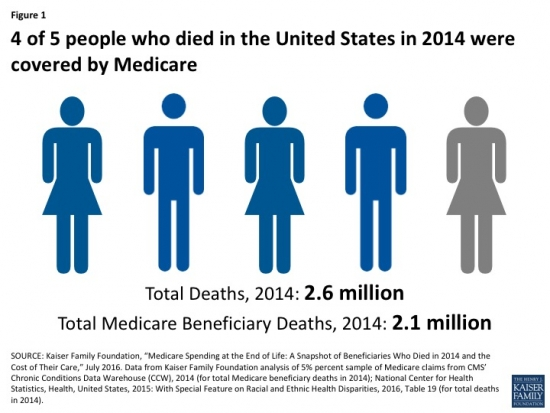
Of the 2.6 million people who died in the U.S. in 2014,1 2.1 million, or eight out of ten, were people on Medicare,2 making Medicare the largest insurer of medical care provided at the end of life. Spending on Medicare beneficiaries in their last year of life accounts for about 25 percent of total Medicare spending on beneficiaries age 65 or older.3
 Four Key Trends:
Four Key Trends:
- About eight of 10 of the 2.6 million people who died in the United States in 2014 were people on Medicare, making Medicare the largest insurer of healthcare provided during the last year of life.
- Research has found, for example, that most adults (90 percent) say they would prefer to receive end-of-life care in their home if they were terminally ill, yet data show that only about one-third of Medicare beneficiaries (age 65 and older) died at home.
- Per capita Medicare spending among decedents in 2014 peaked at age 73 ($43,353) and decreased by almost half ($23,181) by age 95.
- Approximately half of total Medicare spending for people who died in a given year goes toward hospital inpatient expenses, while hospice and skilled nursing services each accounted for about 10 percent of Medicare spending.
The Conversation: A Revolutionary Plan for End-of-Life Care
Dr. Angelo Volandes is a physician, writer and patients’ rights advocate. He is Co-Founder and President of Advance Care Planning Decisions, a non-profit foundation implementing systems and technologies to improve the quality of care delivered to patients in the healthcare system. Dr. Volandes practices internal medicine at Massachusetts General Hospital in Boston and is on faculty at Harvard Medical School. He is also the author of the new book “The Conversation: A Revolutionary Plan for End-of-Life Care,” about how people can empower themselves to get the right medical care at the right time and on their terms.
In The Conversation, Dr. Angelo Volandes offers a solution that is medicine’s oldest and least technological tool: talking. Studies suggest there are numerous barriers to communication between doctors and patients. For individuals to be empowered, they must be informed. He calls for a radical re-envisioning of the patient-doctor relationship. He offers ways for patients and their families to talk about the difficult issue of end-of-life choices to ensure that patients are at the center and in charge of their medical care. Dr. Volandes has a considerable amount of experience and has demonstrated success and clinical benefits of advance care planning, including videos as a tool for empowerment.
For more information on Dr. Volandes and the topic of advanced care planning, visit Advanced Care Planning Decisions. The site houses patient and provider tools, apps and guides, testimonials, links to video tools and a wealth of related information. We have also included several related journal articles and publications on Dr. Volandes’ work on the Nebraska Healthcare Quality Forum Web page.
Sources:
- National Center for Health Statistics, Health, United States, 2015: With Special Feature on Racial and Ethnic Health Disparities, 2016, Table 19: “Leading causes of death and numbers of deaths, by sex, race, and Hispanic origin: United States, 1980 and 2014,” available at http://www.cdc.gov/nchs/data/hus/hus15.pdf#019.
- Kaiser Family Foundation analysis of a five percent sample of 2014 Medicare claims from the Centers for Medicare & Medicaid Services’ Chronic Conditions Data Warehouse.
- Gerald F. Riley and James D. Lubitz, “Long-Term Trends in Medicare Payments in the Last Year of Life,” Health Services Research April 2010; 45(2):565-576.
